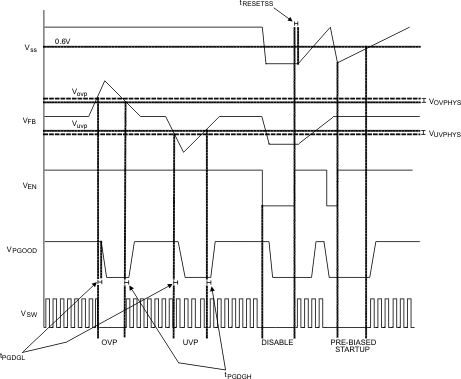JAJSBH3D March 2011 – May 2019 LM21215A
PRODUCTION DATA.
- 1 特長
- 2 アプリケーション
- 3 概要
- 4 改訂履歴
- 5 Pin Configuration and Functions
- 6 Specifications
- 7 Detailed Description
- 8 Application and Implementation
- 9 Power Supply Recommendations
- 10Layout
- 11概要(続き)
- 12デバイスおよびドキュメントのサポート
- 13メカニカル、パッケージ、および注文情報
パッケージ・オプション
メカニカル・データ(パッケージ|ピン)
- PWP|20
サーマルパッド・メカニカル・データ
- PWP|20
発注情報
7.3.4 PGOOD Indicator
The PGOOD flag provides the user with a way to monitor the status of the LM21215A. In order to use the PGOOD function, the application must provide a pullup resistor to a desired DC voltage, for example VIN. PGOOD responds to a fault condition by pulling PGOOD low with the open-drain output. PGOOD pulls low on the following conditions: 1) VFB moves above or below the VOVP or VUVP, respectively; 2) The EN voltage is brought below the Enable turn-off threshold; 3) A pre-biased output condition exists (VFB > VSS/TRK). PGOOD has 12 μs and 15 μs of built-in deglitch time for rising and falling edges, respectively.
Figure 24 shows the conditions that cause PGOOD to respond.
 Figure 24. PGOOD Indicator Operation
Figure 24. PGOOD Indicator Operation